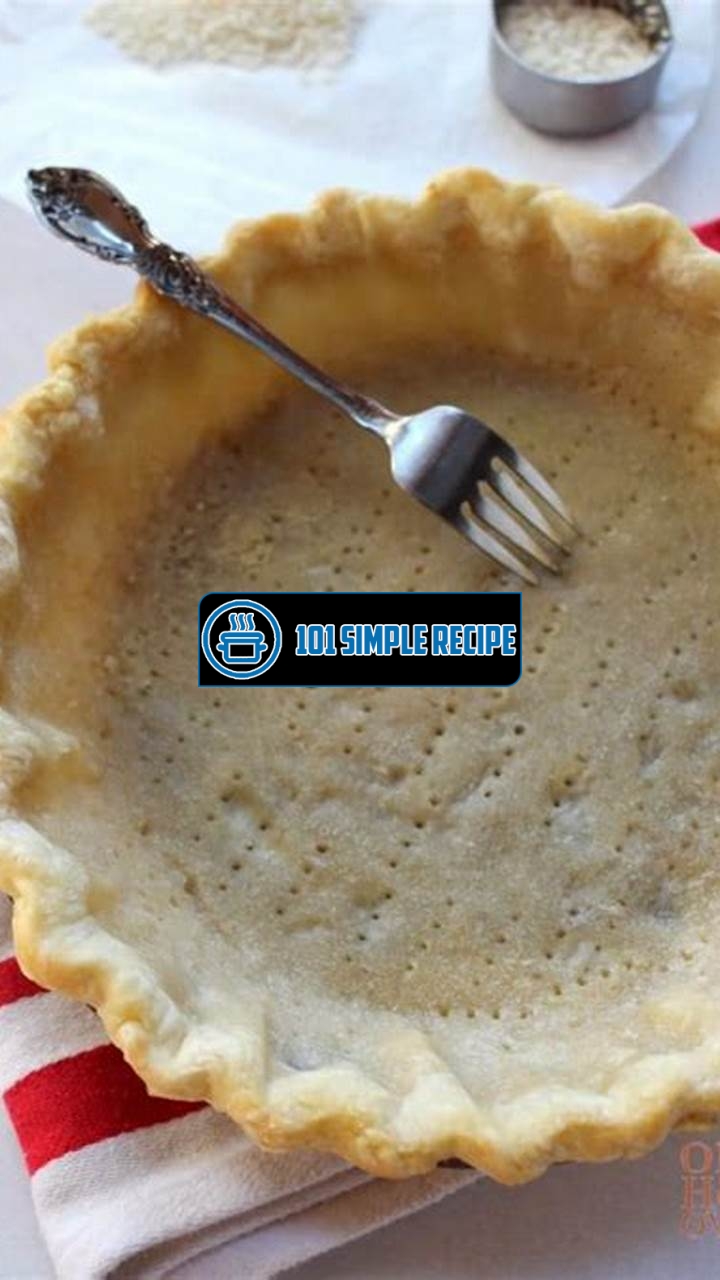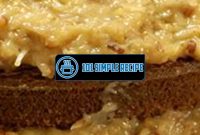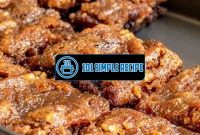Baking a deliciously flaky pie crust that rivals the skills of a professional pastry chef may seem like a daunting task, but fear not! With a few simple tips and tricks, you can easily elevate your pie game to new heights. This guide will take you through the step-by-step process of creating a mouthwatering crust that will leave your taste buds begging for more. From choosing the right ingredients to mastering the art of rolling out the dough, you’ll learn all the secrets to achieving that elusive perfect crust. So let’s get started and embark on a delightful baking adventure together! ✨

The Science Behind Perfect Pie Crust
When it comes to baking a flawless pie crust, there are several essential elements that you need to consider. From choosing the right ingredients to mastering the art of mixing and employing the perfect rolling technique, each step plays a crucial role in creating a deliciously flaky crust that will impress even the most discerning palate.
Choosing the Right Ingredients
The first step in baking a perfect pie crust is selecting the right ingredients. The key components of a pie crust are flour, fat, liquid, and salt. Each ingredient plays a unique role in achieving the desired texture and flavor.
- Flour: Use all-purpose flour for a versatile and dependable crust. It provides the structure and stability needed to hold the filling.
- Fat: Choose a solid fat such as butter or shortening, as they create a flaky texture. These fats need to be chilled before incorporating them into the dough.
- Liquid: Water is the most common liquid used in pie crust recipes. It helps bind the ingredients together and adds moisture to the dough.
- Salt: A pinch of salt enhances the flavor of the crust and balances the sweetness of the filling.
Mastering the Art of Mixing
Once you have gathered your ingredients, it’s time to mix them together. The mixing process is crucial for achieving a tender and flaky crust.
Start by combining the flour, salt, and fat using a pastry cutter or your fingertips. The goal is to create pea-sized crumbs. This step helps distribute the fat evenly, ensuring a tender crust.
Next, add the cold liquid gradually while mixing the dough with a fork. Be careful not to overmix, as this can lead to a tough crust. Stop mixing once the dough comes together and forms a ball.
The Perfect Rolling Technique
Rolling out the dough is the final step before transferring it into the pie dish. The technique you employ can greatly affect the end result.
Start by lightly dusting your work surface and rolling pin with flour. This prevents the dough from sticking and tearing. Divide the dough into two portions if making a double-crust pie.
Gently roll the dough from the center outward, rotating it occasionally to maintain an even thickness. Use quick, light strokes to avoid pressing too hard and making the crust dense.
Once the desired size is achieved, carefully transfer the rolled dough onto the pie dish. Trim any excess overhang and crimp the edges for a decorative finish.
Remember, the key to a perfect pie crust is the combination of the right ingredients, proper mixing technique, and careful rolling. With practice and attention to detail, you can bake deliciously flaky pie crusts like a pro!
Creating the Perfect Pre-Baked Pie Crust
When it comes to pie-making, the crust is the foundation of a delicious dessert. Achieving a beautifully golden and crisp pre-baked pie crust may seem challenging, but with the right techniques, you can bake like a pro. In this article, we will explore the secrets to creating the perfect pre-baked pie crust, from blind baking to preventing shrinkage, and adding the finishing touch with an egg wash.
Blind Baking: The Initial Step
Blind baking is a crucial step in ensuring a flaky and evenly cooked pre-baked pie crust. This method involves partially or fully baking the crust before adding the filling. To blind bake your pie crust, follow these steps:
- Prepare the crust: Roll out the pie dough on a lightly floured surface and carefully transfer it to a pie dish. Gently press the dough into the dish, ensuring it covers the bottom and sides evenly.
- Prick the dough: Using a fork, gently prick the bottom of the crust. This helps prevent air bubbles from forming during baking.
- Weigh it down: To prevent the crust from puffing up, line it with parchment paper or aluminum foil and fill it with pie weights or dried beans.
- Bake the crust: Preheat your oven to the recommended temperature for your pie recipe. Place the pie dish with the weighted crust in the oven and bake for the specified time. Remove the weights and parchment paper/foil during the last few minutes to allow the crust to brown.
By blind baking your pie crust, you ensure that it doesn’t become soggy when filled and maintains its flaky texture.
Preventing Shrinkage
Shrinkage can be a common issue when baking pie crust, resulting in a less visually appealing end product. To prevent shrinkage, keep the following tips in mind:
- Chill the dough: After preparing the pie crust, refrigerate it for at least 30 minutes before blind baking. This helps relax the gluten in the dough, reducing the chances of shrinkage.
- Use pie weights: As mentioned earlier, using pie weights or dried beans during blind baking helps keep the crust in place and prevents it from shrinking.
- Properly seal the edges: Ensure that the edges of the crust are tightly sealed to the pie dish. This helps maintain the shape and prevents shrinkage.
- Avoid overworking the dough: Handle the dough gently and avoid excessive kneading or rolling. Overworking the dough can activate the gluten and result in shrinkage.
Following these tips will help you achieve a perfectly formed pie crust without any shrinkage.
Egg Wash: The Finishing Touch
Add a professional touch to your pre-baked pie crust by giving it an egg wash. An egg wash not only enhances the appearance of the crust but also adds flavor and helps it achieve a beautiful golden color. Here’s how to apply an egg wash:
- Prepare the egg wash: In a small bowl, beat an egg with a tablespoon of water or milk until well combined.
- Brush the crust: Using a pastry brush, gently brush the egg wash over the entire surface of the pre-baked pie crust.
- Optional: For a sweeter crust, sprinkle some sugar on top of the egg wash.
The egg wash will create a glossy finish and add that extra touch of perfection to your pie crust.
With these secrets in mind – blind baking, preventing shrinkage, and applying an egg wash – you are now equipped to bake a deliciously flaky pre-baked pie crust like a pro. So go ahead and impress your friends and family with your pie-making skills!
Whole Foods Chantilly Cake Recipe
Filling and Baking Your Pie
When it comes to creating a deliciously flaky pie crust, the filling and baking process is just as important as the crust itself. Follow these tips to ensure your pie turns out to be a luscious, flavorful masterpiece.
Choosing the Right Filling
The filling you choose for your pie can make all the difference in its taste and texture. Whether you prefer fruit, custard, or cream-based fillings, here are some key points to consider:
- Balance the flavors: When selecting a filling, aim for a balance of sweetness, tartness, and acidity. This will enhance the overall taste of your pie.
- Consider the texture: Think about the consistency you want your filling to have. Some fruits may release more liquid when baked, resulting in a juicier filling.
- Play with spices: Adding spices like cinnamon, nutmeg, or ginger can elevate the flavor profile of your pie. Experiment with different combinations to find your favorite.
- Try a mix of fruits: Combining different fruits can add complexity to your pie. Consider mixing berries, apples, pears, or peaches for a unique flavor experience.
Avoiding Soggy Crusts
One common issue many bakers face when making pies is a soggy crust. Follow these tips to ensure your crust stays perfectly crisp:
- Prevent fruit juice leakage: If you’re making a fruit pie, pre-cook the filling slightly to reduce excess liquid. This will help prevent the crust from becoming soggy.
- Blind bake your crust: Blind baking means partially cooking the crust before adding the filling. This technique creates a barrier between the crust and the filling, preventing sogginess.
- Egg wash: Before adding the filling, brush the bottom of the crust with beaten egg whites. This creates a seal that prevents any excess moisture from seeping into the crust.
- Use a pie shield: To avoid over-browning of the crust edges, protect them with a pie shield or aluminum foil during baking.
The Perfect Temperature and Baking Time
The temperature and baking time are crucial to achieving a perfectly baked pie. Follow these guidelines for the best results:
- Preheat your oven: Always preheat your oven to the recommended temperature before baking your pie. This ensures even baking and a crisp crust.
- Monitor the crust color: Keep an eye on the crust during baking. If it starts to brown too quickly, cover it with foil to prevent it from getting too dark.
- Check for doneness: To check if your pie is fully baked, insert a toothpick or skewer into the center of the filling. If it comes out clean or with a few crumbs, your pie is ready.
- Cooling time: Allow your pie to cool completely before serving. This will give the filling time to set and the flavors to develop.
With these tips in mind, you can confidently bake a pie with a flaky, golden crust that will impress everyone. So go ahead and choose your favorite filling, take your time in the kitchen, and enjoy the process of creating a pie like a pro!
Enhancing Your Pie Crusts with Flavor
When it comes to baking a pie, the filling often takes center stage. But let’s not forget about the importance of a deliciously flaky pie crust. It’s the foundation that holds everything together and provides that satisfying crunch with each bite. If you want to take your pie crusts to the next level, here are some simple yet creative ways to add an extra punch of flavor.
Infusing Your Crust with Herbs and Spices
One way to elevate the taste of your pie crust is by infusing it with herbs and spices. This not only adds flavor but also creates a delightful aroma that will have everyone’s mouths watering. Consider adding dried herbs like thyme, rosemary, or basil to your crust dough. These earthy flavors pair well with savory fillings such as chicken pot pie or quiche. If you prefer a touch of heat, sprinkle in some chili powder or cayenne pepper for a spicy kick. Experiment with different combinations to find your favorite flavor profile.
✨ Tip: Infusing your pie crust with herbs and spices adds depth and complexity to your baked creations.
Exploring Different Types of Sugars
Who said sugar has to be just sweet? By exploring different types of sugars, you can bring a whole new dimension of flavor to your pie crust. Swap out regular granulated sugar with alternatives such as brown sugar, honey, or maple syrup. These sweeteners have distinct tastes that will lend a unique character to your crust. Brown sugar adds a rich caramel flavor, while honey provides a floral sweetness. And let’s not forget about the irresistible maple syrup. Use these sugars in their liquid forms to ensure they incorporate seamlessly into the dough.
✨ Tip: Experimenting with different sugars allows you to create a personalized flavor profile for your pie crust.
Create an Irresistible Nutty Crust
If you’re a fan of nutty flavors, incorporating nuts into your pie crust is a game-changer. Finely chop your favorite nuts, such as almonds, pecans, or walnuts, and mix them into your dough. Not only does this add a delightful crunch, but it also infuses your crust with a rich, toasty taste. The combination of buttery pastry and nutty goodness is a match made in dessert heaven. Try pairing a nutty crust with fruit fillings like apple or cherry for a delightful contrast of flavors.
✨ Tip: A nutty crust adds texture and a hint of indulgence to your pie, making it a memorable dessert.
In conclusion, enhancing your pie crusts with flavor doesn’t have to be complicated. By infusing your crust with herbs and spices, exploring different types of sugars, or creating a nutty crust, you can take your pie baking game to new heights. These simple yet creative techniques will impress your taste buds and have your guests coming back for seconds. So roll up your sleeves, grab your rolling pin, and get ready to bake a deliciously flaky pie crust like a pro!
Perfecting Decorative Pie Crust Designs
Unleash your creativity and impress your guests with stunning and intricate pie crust designs. From simple yet stunning lattice patterns to mastering the art of rose designs and creating intricate cutouts, there are endless possibilities to elevate your pie crust game. Whether you’re baking for a special occasion or simply want to add an extra touch of elegance to your homemade pies, these decorative designs will take your baking skills to the next level.
Simple Yet Stunning Lattice Pattern
The lattice pattern is a classic and elegant choice for pie crusts. It adds visual appeal and allows the filling to peek through, making it a favorite among both bakers and pie enthusiasts. Creating a lattice pattern may seem intimidating, but with a little practice, you’ll be able to achieve beautiful results.
To create a lattice pattern, start by rolling out your pie dough and cutting it into thin, even strips. Lay half of the strips horizontally across the pie filling, spaced evenly apart. Fold every other strip back halfway and place a strip vertically across the unfolded strips. Repeat this process, alternating the folded and unfolded strips, until you’ve covered the entire pie. Trim any excess crust, press the edges to seal, and crimp with a fork for a finished look. Brush the crust with an egg wash for a golden and glossy finish.
This simple yet stunning lattice pattern will impress your guests and make your pie the star of the show.
Mastering the Art of Rose Design
Nothing says elegance like a beautifully crafted rose design on a pie crust. With a little patience and attention to detail, you can create a truly impressive centerpiece for your dessert table.
To master the art of the rose design, start by rolling out your pie dough and cutting it into a large circle. Using a small knife or a decorative pie crust cutter, create long, thin strips of dough. Take one strip and roll it tightly to form the center of the rose. Place it in the center of the pie crust circle. Take another strip and coil it around the center, slightly overlapping the previous strip. Continue coiling the dough strips around the center until you’ve formed a beautiful rose shape.
Once you’ve completed the rose design, carefully transfer the pie crust to your pie dish. Press the edges to seal and crimp with a fork. Brush the crust with an egg wash for a glossy finish. The rose design will not only impress your guests but also add a touch of artistry to your pie.
Creating Intricate Cutouts
If you want to take your pie crust designs to the next level, creating intricate cutouts is the way to go. This technique allows you to personalize your pie crust and showcase your creativity. From intricate patterns to personalized messages, the possibilities are endless.
To create intricate cutouts, roll out your pie dough and cut it into desired shapes using small cookie cutters or a sharp knife. Arrange the cutouts on top of your pie filling, making sure to leave enough space for the filling to expand while baking. Brush the crust with an egg wash for a golden and crisp finish.
Whether you choose to create a starry night sky with tiny star-shaped cutouts or spell out “Happy Birthday” with alphabet-shaped cutouts, these intricate designs will make your pie truly unique. ✨
Now that you know the secrets to perfecting decorative pie crust designs, it’s time to let your creativity soar. Whether you opt for a simple lattice pattern, a beautiful rose design, or intricate cutouts, these techniques will take your pies to the next level. Wow your guests with stunning and professional-looking pie crusts, and enjoy the deliciously flaky results!
Baking Soda Weight Loss Recipe
Thank you for taking the time to read this article on baking pie crust. We hope you found the information helpful and that it inspires you to try making your own delicious pies at home. If you have any questions or need further assistance, feel free to reach out to us. Don’t forget to visit our website again for more baking tips, recipes, and inspiration. Happy baking!
Frequently Asked Questions
Here are some frequently asked questions about baking pie crust:
| No. | Questions | Answers |
|---|---|---|
| 1. | What is the best type of fat to use for pie crust? | The best type of fat to use for pie crust is cold unsalted butter. It creates a flaky texture and adds a rich flavor to the crust. |
| 2. | Should I use salted or unsalted butter for pie crust? | It is recommended to use unsalted butter for pie crust, as it allows you to control the amount of salt in the recipe. |
| 3. | Why should I chill the pie dough before rolling it out? | Chilling the pie dough before rolling it out helps to relax the gluten and prevents the crust from shrinking while baking. It also makes it easier to handle and results in a flakier crust. |
| 4. | Can I use a food processor to make pie crust? | Yes, you can use a food processor to make pie crust. It helps to quickly cut the butter into the flour, resulting in a flaky crust. Just be careful not to over-process the dough. |
| 5. | How do I prevent the edges of the pie crust from burning? | To prevent the edges of the pie crust from burning, you can use a pie crust shield or cover them with strips of aluminum foil. This will help to protect the crust while allowing the filling to cook. |
| 6. | Can I freeze unbaked pie crust? | Yes, you can freeze unbaked pie crust. Just wrap it tightly in plastic wrap or place it in a freezer bag. When you’re ready to use it, thaw it in the refrigerator overnight before rolling it out. |
Closing Thoughts
We hope this article has provided you with valuable insights into the art of baking pie crust. Remember to use cold unsalted butter for the best results and don’t forget to chill the dough before rolling it out. Experiment with different fillings and get creative with decorative crust designs. With practice, you’ll be able to master the art of making perfect pie crusts that will impress your family and friends. Keep visiting our website for more delicious recipes and baking tips. Happy baking!
Jump to Recipe
Baking Pie Crust

Learn how to bake the perfect pie crust with this easy recipe. Follow these step-by-step instructions for a flaky and delicious crust that will elevate your pies to the next level.
- 1 1/4 cups all-purpose flour
- 1/2 teaspoon salt
- 1/2 cup unsalted butter (cold and cubed)
- 3-4 tablespoons ice water
- In a large bowl, whisk together the flour and salt.
- Add the cold cubed butter to the flour mixture. Use a pastry cutter or your fingers to blend the butter into the flour until the mixture resembles coarse crumbs.
- Gradually add ice water, 1 tablespoon at a time, and mix until the dough comes together. Be careful not to overmix.
- Shape the dough into a ball, flatten it into a disc, and wrap it in plastic wrap. Refrigerate for at least 30 minutes before rolling it out.
- When ready to use, remove the dough from the refrigerator and let it sit at room temperature for a few minutes to soften slightly. Roll out the dough on a lightly floured surface to fit your pie dish.
- Carefully transfer the rolled-out dough to your pie dish. Trim any excess and crimp the edges as desired. Fill with your favorite pie filling and bake according to the recipe instructions.






